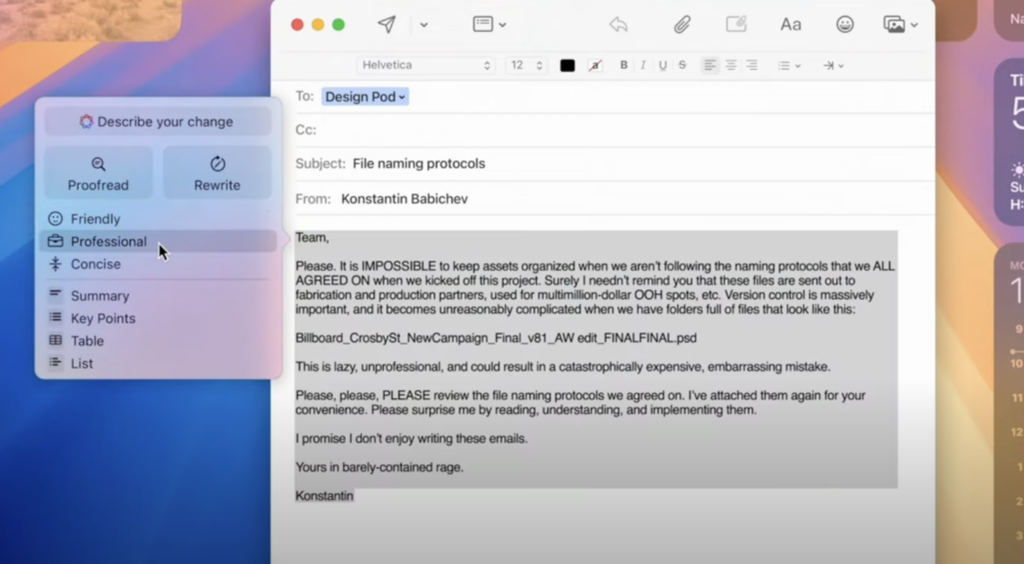Apple Intelligence is a groundbreaking AI system that combines the power of generative models with personal context to deliver intelligence that is incredibly useful and relevant for users. This innovative technology is deeply integrated into iOS 18, iPadOS 18, and macOS Sequoia, empowering users to communicate, work, and express themselves more effectively across their devices.
New Features and Capabilities

- Generative AI Meets Personal Context: Apple Intelligence understands personal context to deliver intelligence that is helpful and relevant for each user. This integration of AI and personal context simplifies and accelerates everyday tasks, making it easier to manage emails, notifications, and other tasks.
- New Writing Tools: Apple Intelligence includes advanced writing tools that can rewrite, proofread, and summarize text. These tools are available across various apps, including Mail, Notes, Pages, and Keynote, helping users refine their writing and communicate more effectively.
- Smart Features in Mail and Notifications: Apple Intelligence enhances the email experience by providing priority messages, summaries, and smart replies. It also prioritizes smart notifications, allowing users to identify the most important messages quickly.
- Creative Image Tools: Apple Intelligence includes Image Playground, a feature that enables users to create custom images and emojis using various styles and features. This tool is available across apps like Messages, Notes, Pages, Keynote, and Freeform.
- Siri Enhancements: Siri has been significantly upgraded with Apple Intelligence, allowing it to understand natural language, remember conversations, and provide more contextual and relevant information.
- Memories and Memory Movies: Apple Intelligence makes it much easier to create personalized memory movies from your photos and videos. You can simply type a description of the memory you want to see, and Apple Intelligence will automatically select the best photos and videos, arrange them into a movie with unique chapters and a narrative arc, and set it to the perfect song from Apple Music.
- Audio Transcription in Notes: In the Notes app, you can now record audio and have it automatically transcribed, allowing you to capture detailed notes while staying present in the moment.
- Immersive Video Content: Apple is working on new immersive video content for Apple Vision Pro, including a new extreme sports series with Red Bull and reimagined experiences from artists like The Weeknd, as well as a scripted short film from an Oscar-winning director.
- Spatial Photos and Gestures in Vision OS 2: Vision OS 2 introduces a new way to turn your favorite photos into spatial photos, as well as new intuitive gestures and a boost to productivity with Mac virtual display and powerful new developer APIs.
Apple Intelligence is available in beta with the upcoming iOS 18, iPadOS 18, and macOS Sequoia releases, scheduled for fall 2024.
Comparing Apple Intelligence to other AI technologies
The table below highlights the key features and differences between Apple Intelligence and other AI technologies like ChatGPT, Google AI, and Microsoft AI. Apple Intelligence stands out for its focus on personalization and on-device processing, ensuring privacy and security for users.
| Feature | Apple Intelligence | ChatGPT, Gemini. Bing AI |
|---|---|---|
| Generative Capabilities | Multimodal generative capabilities, including text and images | Text and image generation, with a focus on text |
| Personalization | Uses personal context to provide relevant and helpful intelligence | Uses user data to provide personalized responses |
| On-Device Processing | Processes most data on-device, ensuring privacy and security | Processes data on-device but can also use cloud processing |
| Cloud Processing | Uses Private Cloud Compute for secure and private cloud processing | Uses cloud processing for more complex tasks |
| Integration | Integrated with Siri and offers ChatGPT | Integrated with various platforms and services |
| Data Collection | It does not collect user data; it uses on-device processing for privacy and security. | Collects user data for personalized responses |
| Accessibility | Available on iPhone, iPad, and Mac devices | Available on various platforms and services |
| Cost | Free for Apple device users; optional ChatGPT subscription available | Free for basic use; optional subscription for advanced features |
ChatGPT integration within Siri
Apple Intelligence will have the ability to summarize web images, empowering users to communicate and express themselves in new ways. With Image Playground, users can create fun images in seconds, choosing from three styles: Animation, Illustration, or Sketch.
This feature is built into apps like Messages, Notes, Keynote, Freeform, and Pages, making it easy to incorporate creative images into daily workflows. ChatGPT will be integrated within Siri, along with systemwide Writing Tools across Apple’s platforms. This integration will power documents as well as the image processing capabilities of the app’s tools.
ChatGPT will be usable across Apple devices, allowing users to access its capabilities without needing to log in or without information leaving the device. Paid ChatGPT users will be able to connect their accounts to the platform, enabling seamless integration with Apple’s ecosystem.
When using ChatGPT, users are asked before any questions are sent to the AI, along with any documents or photos, and Siri then presents the answer directly. This ensures that users are always in control of their data and that their privacy is protected. Apple Intelligence prioritizes user privacy and security, obscuring IP addresses and not storing requests. This means that users can enjoy the benefits of ChatGPT without compromising their personal data.
Incorporating Apple Intelligence into Your Apps
Apple Intelligence offers a range of tools and features that can be integrated into various apps, enhancing the user experience and improving communication and productivity. Here are some ways publishers can incorporate Apple Intelligence into their apps:
- Rewrite, Proofread, and Summarize Text: Apple Intelligence includes advanced writing tools that can rewrite, proofread, and summarize text. Publishers can integrate these tools into their apps to help users refine their writing and communicate more effectively.
- Smart Features in Mail and Notifications: Apple Intelligence enhances the email experience by providing priority messages, summaries, and smart replies. Publishers can leverage these features to improve user engagement and streamline communication.
- Creative Image Tools with Image Playground: Apple Intelligence includes Image Playground, a feature that enables users to create custom images and emojis using various styles and features. Publishers can use this tool to create engaging visual content for their apps.
- Action Across Apps: Apple Intelligence can take action across apps on behalf of users. Publishers can use this feature to automate tasks and simplify workflows within their apps.
- Personal Context and Data Analysis: Apple Intelligence can retrieve and analyze user data from across apps to provide personalized insights. Publishers can leverage this feature to offer more targeted and relevant content to their users.
Benefits of using Apple Intelligence for editorial workflow optimization

Apple Intelligence offers several benefits for editorial workflow optimization in publishing operations:
- Streamlined Content Creation: Apple Intelligence’s generative AI capabilities can assist in writing, proofreading, and summarizing text, reducing the time and effort required for content creation. This can be particularly useful for tasks such as rewriting, proofreading, and summarizing text, freeing up editors to focus on higher-level creative tasks.
- Enhanced Collaboration: Apple Intelligence’s ability to integrate with various apps and services can facilitate seamless collaboration among team members. For example, it can help in creating custom emojis and images for messages, making communication more engaging and personalized.
- Personalized Content Recommendations: Apple Intelligence can analyze user data and provide personalized content recommendations based on their preferences. This can help publishers create targeted content that resonates with their audience, increasing engagement and reader retention.
- Improved Content Organization: Apple Intelligence’s ability to organize and categorize content based on personal context can help editors quickly locate specific information and manage their workflow more efficiently. This can be particularly useful for tasks such as finding specific articles or managing multiple projects simultaneously.
- Enhanced User Experience: Apple Intelligence’s integration with Siri and other Apple services can provide a more seamless and intuitive user experience, making it easier for readers to access and engage with content. This can lead to increased reader satisfaction and loyalty.
- Increased Productivity: Apple Intelligence’s automation capabilities can help streamline workflows and reduce the time spent on repetitive tasks, allowing editors to focus on higher-level creative tasks and increasing overall productivity.
- Better Content Discovery: Apple Intelligence’s ability to analyze user data and provide personalized content recommendations can help publishers discover new topics and trends that are relevant to their audience, enabling them to create more targeted and engaging content.
- Enhanced Content Analysis: Apple Intelligence’s advanced analytics capabilities can help publishers analyze and understand their audience better, providing insights that can inform content creation and marketing strategies.
- Improved Content Quality: Apple Intelligence’s proofreading and rewriting capabilities can help ensure that content is accurate, well-written, and engaging, enhancing the overall quality of the content and improving reader satisfaction.
Overall, Apple Intelligence offers a range of benefits that can enhance editorial workflow optimization, improve content creation, and provide a more seamless and engaging user experience for readers.
Privacy Implications of Using Apple Intelligence

The privacy implications of using Apple Intelligence are significant and multifaceted. Here are some key points to consider:
- On-Device Processing: Apple Intelligence processes most of its AI tasks on-device, using Apple silicon chips like the A17 or M-series. This ensures that sensitive data remains within the user’s device and is not transmitted to external servers.
- Private Cloud Compute: Apple uses Private Cloud Compute for more complex tasks that require additional processing power. This proprietary cloud infrastructure is designed to ensure that data is never retained or exposed. It uses Apple’s own Swift programming language and is thoroughly within the Apple ecosystem.
- Data Protection: Apple emphasizes that it does not collect or retain any user data. The company claims that even Apple itself cannot access the data processed by Apple Intelligence, ensuring that user privacy is maintained.
- User Control: Users have control over how Apple Intelligence processes their data. For example, they can choose to use the “lock” feature to restrict certain apps from accessing their data.
- Transparency: Apple provides transparency in its AI processes, allowing users to inspect the code that runs on Apple silicon servers to verify privacy.
- Security: Apple Intelligence is designed to be secure, with features like Reduce Interruptions that help users stay present in what they are doing by only surfacing notifications that require immediate attention.
- AI Integration with Siri: Apple is integrating ChatGPT and GPT-4o with Siri, which will be used for tasks like referencing current information or gathering information not on the user’s device. Siri will ask for permission to access these AI models, and users can choose to use them for free or connect to their personal ChatGPT subscription.
- Generative AI: Apple Intelligence uses generative AI models to create custom emojis, images, and text. These models are designed to understand personal context and provide helpful and relevant intelligence to users.
Apple Intelligence is designed to prioritize user privacy and security while providing powerful AI capabilities. By processing most tasks on-device and using proprietary cloud infrastructure, Apple ensures that sensitive data remains within the user’s control and is not exposed to external entities.
Apple Intelligence for Gaming

Apple Intelligence can be a powerful tool for enhancing gaming experiences and improving game development. Apple Intelligence offers multimodal generative capabilities, which can be used to enhance gaming experiences. For example, it can generate text and images to create personalized gaming content, such as generating custom levels or characters based on user preferences. Additionally, Apple Intelligence can help improve game writing by proofreading or rewriting text, making it more engaging and immersive for players.
Apple Intelligence can also be used to create more realistic game environments by generating images and text based on user context. For instance, it can generate images of a player’s character in a specific location or scenario, enhancing the overall gaming experience.
In terms of specific graphics enhancements, Apple Intelligence can improve the rendering of 3D models and textures in games, making them more detailed and realistic. It can also enhance the performance of games by optimizing graphics processing and reducing lag.
Furthermore, Apple Intelligence can be integrated into game development tools to help developers create more personalized and engaging games. For example, it can be used to generate custom game levels or characters based on user preferences, making the game more enjoyable and interactive.
Conclusion
Apple Intelligence offers a range of tools and features that can be integrated into various apps to enhance user experiences and improve communication and productivity. By incorporating Apple Intelligence into your apps, create more engaging and personalized experiences for users, increase user retention and satisfaction, and stay ahead of the competition.
source https://www.monetizemore.com/blog/apple-intelligence/



0 Comments